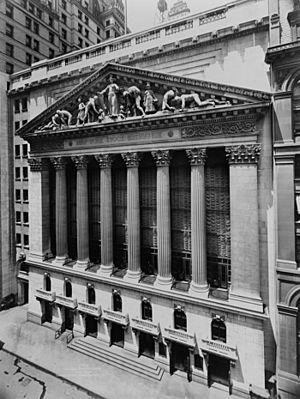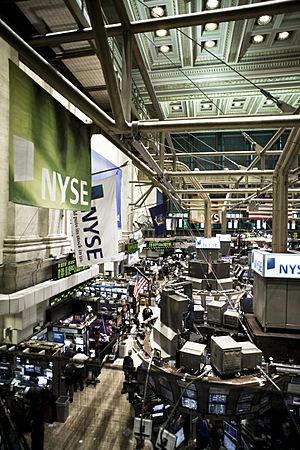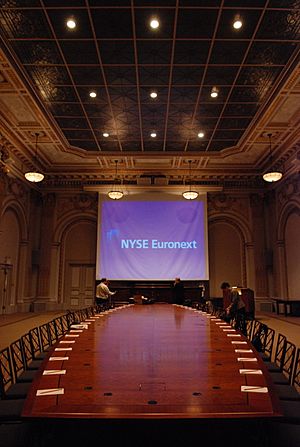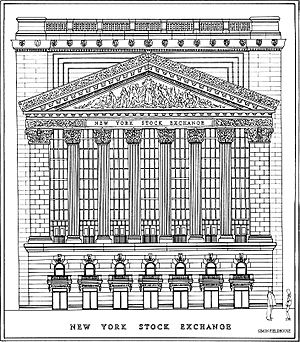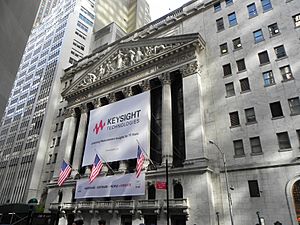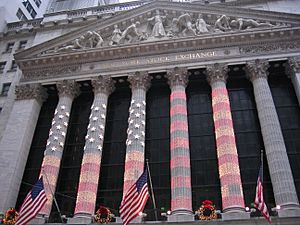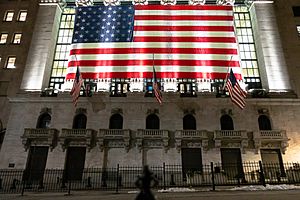New York Stock Exchange Building facts for kids
|
New York Stock Exchange
|
|
|
U.S. Historic district
Contributing property |
|
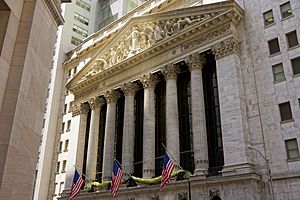
Broad Street facade of the 18 Broad Street section of the building
|
|
| Location | 18 Broad Street, Manhattan, New York |
|---|---|
| Built | 1903 |
| Architect | Trowbridge & Livingston; George B. Post |
| Architectural style | Classical Revival |
| Part of | Wall Street Historic District (ID07000063) |
| NRHP reference No. | 78001877 |
Quick facts for kids Significant dates |
|
| Added to NRHP | June 2, 1978 |
| Designated NHL | June 2, 1978 |
The New York Stock Exchange Building (also the NYSE Building) is a structure in the Financial District of Manhattan in New York City, serving as the headquarters of the New York Stock Exchange (NYSE). It is composed of two connected structures occupying two-thirds of the city block bounded by Wall Street, Broad Street, New Street, and Exchange Place. The central third of the block contains the original structure at 18 Broad Street, designed in the neoclassical style by George B. Post. The northern third contains a 23-story office annex at 11 Wall Street, designed by Trowbridge & Livingston in a similar style.
The marble facade of 18 Broad Street contains colonnades facing east toward Broad Street and west toward New Street, both atop two-story podiums. The Broad Street colonnade, an icon of the NYSE, contains a pediment designed by John Quincy Adams Ward, depicting commerce and industry. The facade of 11 Wall Street is simpler in design but contains architectural details similar to those at 18 Broad Street. Behind the colonnades at 18 Broad Street is the main trading floor, a 72-foot-tall (22 m) rectangular space. An additional trading floor, nicknamed the Garage, is at 11 Wall Street. There are offices and meeting rooms in the upper stories of 18 Broad Street and 11 Wall Street.
The NYSE had occupied the site on Broad Street since 1865, but had to expand its previous building several times due to overcrowding. The structure at 18 Broad Street was erected between 1901 and 1903, replacing the previous building. Within two decades, the NYSE's new building had become overcrowded, and the annex at 11 Wall Street was added between 1920 and 1922. Three more trading floors were added in the late 20th century to accommodate increasing demand, and there were several proposals to move the NYSE elsewhere during that time. With the growing popularity of electronic trading in the 2000s, the three newer trading floors were closed in 2007.
The building was designated a National Historic Landmark in 1978 and designated a city landmark by the New York City Landmarks Preservation Commission in 1985. The building is also a contributing property to the Wall Street Historic District, a National Register of Historic Places district created in 2007.
Contents
Site
The New York Stock Exchange Building is in the Financial District of Manhattan, occupying the city block between Broad Street to the east, Wall Street to the north, New Street to the west, and Exchange Place to the south. The lot has a total area of 31,350 square feet (2,913 m2). Nearby buildings include 1 Wall Street to the west; 14 Wall Street to the north; Federal Hall National Memorial to the northeast; 23 Wall Street and 15 Broad Street to the east; Broad Exchange Building to the southeast; and 30 Broad Street to the south. The Broad Street station of the New York City Subway, serving the J and Z train, originally contained two staircases that led to the sidewalk directly outside the New York Stock Exchange Building. One stair was closed after the September 11 attacks in 2001, while the other was closed in 2012.
The NYSE Building is surrounded by a security zone that was created around the building after the September 11 attacks. In addition, a pedestrian-only zone was established along several blocks immediately surrounding the building. Bollards were installed at several intersections around the building in the mid-2000s. The Downtown Alliance, in 2017, proposed improvements to the pedestrian-only zone surrounding the NYSE Building. The plans included a series of benches placed around the Fearless Girl statue on the Broad Street side of the building. The improvements also included the removal of the Broad Street subway entrances, which was approved in 2019.
Design
The building houses the New York Stock Exchange (NYSE), the world's largest stock exchange per market capitalization of its listed companies. It is at the same location as the NYSE's previous headquarters on the same site, which had dated to 1865. The NYSE Building is composed of two primary structures. The southern structure, at 18 Broad Street in the center of the block, was designed by George B. Post in the classical style and was completed in 1903, directly replacing the former headquarters. The northern structure, at 11 Wall Street on the northern end of the block, has a frontage directly on Wall Street; it was designed by Trowbridge & Livingston and completed in 1922. Due to the site's sloping topography, the first floor is at ground level at the corner of Wall and New Streets, but is one level above Broad Street.
Facade
18 Broad Street
18 Broad Street, the older structure in the modern building, is at the center of the block. The structure has a facade of white Georgia marble and a roof 156 feet (48 m) above sidewalk level. 18 Broad Street has a frontage of 152 feet 10 inches (47 m) on New Street and 137 feet 8.5 inches (42 m) on Broad Street.
Facing Broad Street is a two-story podium made of granite blocks. The podium is subdivided into seven vertical bays of doorways at the basement, which on Broad Street is at ground level, as well as arched windows with balconies on the first story. Each of the basement openings is topped by a decorative lintel, while each short balcony is supported by brackets. South of this podium on Broad Street are two additional bays, which contain an entrance to the offices near the trading floor. It contains a double-height arched opening at basement level, with a flat lintel containing the words stock exchange above the doors. The top of the arch has an ornamented keystone. On New Street, the basement and first stories are clad with rusticated marble blocks, and the openings are simpler in design compared to the Broad Street facade.
Above the podiums on either side are colonnades on the second through fifth stories, each of which have two flat pilasters flanking six columns. Each of the columns is 5.5 feet (1.7 m) in diameter and 52 feet (16 m) tall. The columns on Broad Street are fluted, while those on New Street are not. There are wrought-iron railings between each column. Behind each colonnade is a single massive window, each measuring about 96 feet (29 m) wide by 50 feet (15 m) tall. Each window has 18-inch (460 mm) vertical iron mullions that can support the window's weight and push back against the 75 tons of wind pressure on each window. The southernmost two bays on Broad Street, outside the colonnade, contain pairs of windows on each of the second through eighth stories.
The top of the colonnade on Broad Street is a triangular pediment, originally carved by the Piccirilli Brothers to designs by John Quincy Adams Ward and Paul Wayland Bartlett. The pediment measures about 100 feet (30 m) above the sidewalk and about 110 feet wide. It is composed of eleven figures representing commerce and industry, each ranging between 5 and 16 feet (1.5 and 4.9 m) tall. The central figure is a female representation of Integrity, flanked on the left by figures depicting Agriculture and Mining, and on the right by those depicting Science, Industry and Invention. The figures, originally fashioned from marble, were replaced in 1936 with sheet metal carvings coated with lead. A cornice with egg-and-dart moldings and lions' head carvings runs atop the Broad Street facade; it is topped by a parapet with a balustrade. The New Street facade has a simple cornice.
11 Wall Street
The northern annex at 11 Wall Street is 22 stories tall, or 23 including the ground-level basement on Broad Street, and is constructed of Georgia marble. It occupies an irregular lot extending 58 feet (18 m) on Broad Street, 156 feet (48 m) on Wall Street, and 100 feet (30 m) on New Street. 11 Wall Street has an overall height of 258 feet (79 m). The building's massing, or general form, incorporates several setbacks. At the ninth story, the building is set back from all facades except the Wall Street side. There are further setbacks at the nineteenth and twentieth stories, as well as a roof above the twenty-second story. A heavy cornice runs around 11 Wall Street above the eighteenth story.
The annex's main entrance, a chamfered corner at Wall and New Streets, consists of a rectangular doorway flanked by Doric columns and topped by a transom, entablature, and balustrade. The windows on 11 Wall Street are largely paired, rectangular sash windows.
The 11 Wall Street annex contains design elements that visually connect it to the older building. On Broad Street, a belt course above the first story, two floors above street level, connects with the top of the podium on 18 Broad Street. The balustrade at the ninth story, ten floors above street level, connects with those atop 18 Broad Street. Additionally, on the Wall Street facade is a small row of Corinthian-style flat pilasters flanking the second- through fifth-story windows. These pilasters are similar in design to the colonnades of 18 Broad Street.
Interior
The exchange is the locus for a large amount of technology and data. For example, the trading floor requires 3,500 kilowatts of electricity, along with 8,000 phone circuits on the trading floor alone, and 200 miles of fiber-optic cable below ground.
When the building was first completed, pneumatic tubes and telephones were installed in the trading floor and other parts of the building to facilitate communications. Some 25,000 feet (7,600 m) of pipes were used to heat and cool the offices. Four boilers generated a combined 800 horsepower (600 kW) in steam, while three power generators were capable of a combined 1,040 horsepower (780 kW). In addition, numerous elevators were constructed in the building's constituent structures. Six passenger elevators, three lifts, and five dumbwaiters were provided at 18 Broad Street. Eleven elevators were installed at 11 Wall Street; nine ran only to the 17th floor while the other two served the top six floors.
Basement
There are four basement levels in total. The machinery, electric and steam plants, employee rooms, and vaults are in the basement and subbasement underneath the first-story trading floor. When completed, the building had a steel safe deposit vault measuring about 118.58 feet (36 m) wide, 21 feet (6 m) long, and 9 feet 10 inches (3 m) high. The vault weighed 776 short tons (693 long tons; 704 t) when empty. A corridor in the basement led to the Wall Street station of the city's first subway line (now the 4 and 5 train), under Broadway.
The lowest basement level, 42 feet (13 m) below Wall Street, is surrounded by a concrete cofferdam resting on solid rock. The cofferdam is 8 feet (2.4 m) wide and 50 feet (15 m) deep. The surrounding area had an extremely high water table, with water being found only a few feet below ground, partially because Broad Street was formerly the site of a drainage ditch. As a result, caissons were used to excavate part of the 18 Broad Street site, and the remainder of the basement and subbasement was then excavated. The caissons were built of wood and were 30 by 8 by 50 feet (9 m × 2 m × 15 m) each. John F. O'Rourke was the caisson contractor.
Trading floors
The main trading floor (formerly the board room), on the first story at 18 Broad Street, covers 15,000 square feet (1,400 m2). The room, extending the width of the block between New and Broad Streets, has floor dimensions of 109 by 140 feet (33 by 43 m), with a ceiling 72 feet (22 m) high. The trading floor was laid out to maximize usable space and, as a result, had minimal space for visitors on the floor itself. A narrow gallery for smokers was provided on the New Street side, and an admission area for guests was on Broad Street.
The floor of the room is at the same level as New and Wall Streets; as built, a marble double stair from the basement at Broad Street provided entrance for members. The floor surface was originally covered with wood. The floor is interrupted only by eight iron columns, the placement of which was decided only after twenty to thirty drawings were made. The lowest 20 feet (6.1 m) of the walls is clad in marble, with arched alcoves for access to other rooms. The walls are clad with marble panels, which contain bluish-brownstone centers and pink-marble metopes at the top. The ceiling is supported by four transverse trusses spanning the width of the room, measuring 115 feet (35 m) long and 15 feet (4.6 m) thick. These trusses are carried on pairs of pilasters at each end and subdivide the ceiling into coffers. The center of the ceiling was fitted with a 30-by-30-foot (9.1 by 9.1 m) skylight, while the rest of the ceiling was gilded upon the building's completion.
As constructed, the room had 500 telephones, as well as annunciators clustered around the New Street end and surrounding the large columns on the floor. The northern and southern walls originally had colored "checkerboards" with over 1,200 panels, which could be lit in a variety of patterns to flash a myriad of messages to members on the floor. Each of the four primary trading areas contain the NYSE's opening and closing bells (originally just one bell), which are rung to mark the beginning and the end of each trading day. Abutting the trading floor, but on higher levels, were doctors' rooms, baths, and barbershops for NYSE members. A passageway leads north to the other trading floors at 11 Wall Street; another passage also formerly led south to 20 Broad Street.
There is another trading floor at the northeast section of 11 Wall Street, nicknamed "The Garage". The floor is 106 feet (32 m) long and 50–80 feet (15–24 m) wide, while the ceiling is 43 feet (13 m) high. The decoration is similar to at the main trading floor. Gray marble is used for the walls and public corridors, while the private corridors have Dover marble wainscoting and Alabama marble floors. Until 2007, there were three additional trading floors. The "Blue Room" and the "Extended Blue Room" were within 20 Broad Street, immediately south of the NYSE Building. There was also a trading room at the Continental Bank Building on 30 Broad Street.
Upper stories
The design was required to include a large interior light shaft in the upper stories of 18 Broad Street. The location of this shaft, as well as that of the trading floor’s skylight, was affected by the planning of the various rooms in the upper stories. On the sixth story, above the trading floor, is the board room (formerly the Bond Room). This room has a skylight and coffered ceiling. The walls are decorated with white and gold decorations and contain arches supported by flat pilasters. While the room was originally outfitted with semicircular tiers surrounding a dais, these have since been removed.
The seventh story of 18 Broad Street contained the Luncheon Club facing New Street, which covered 12,055 square feet (1,119.9 m2). The Luncheon Club's main dining room measured 76 by 40 feet (23 by 12 m), with a ceiling 18 feet (5.5 m) high. A smaller dining room was provided for non-smokers, separated from the main dining room by a lounge. The eighth story along New Street contained the club kitchen with a mezzanine-level serving gallery. After the Luncheon Club shut down during 2006, the Luncheon Club space was converted into an event space called Freedom Hall.
The other rooms on the sixth story of 18 Broad Street included the Governor's Room on the Wall Street side, as well as the president's and secretary's rooms, committee rooms, and offices on the New Street side. The Committee on Arrangements and Admission room featured two large brass chandeliers. The other committee rooms on this story were similarly ornate. The seventh and eighth stories facing Broad Street contained committee rooms and offices. There are also offices on the upper floors at 11 Wall Street. Up to the 17th floor, a typical floor at 11 Wall Street contains 7,500 square feet (700 m2) of space, but the top six floors contain only 3,661 square feet (340.1 m2) on average. The upper stories of both structures contain several event spaces.
History
What became the NYSE was founded in 1792, when brokers signed the Buttonwood Agreement, thereby forming an organization for securities trading. Previously, securities exchange had been intermediated by auctioneers. In 1817, the organization reformed as the New York Stock and Exchange Board. The broker organization began renting out space exclusively for securities trading, using several locations for the next half-century, including the Tontine Coffee House. With technological advances in the latter half of the nineteenth century, there was rapid growth in securities trading, and as a result the Stock and Exchange Board also grew rapidly.
Previous structure
In December 1865, the Stock and Exchange Board moved to 10 Broad Street, between Wall Street and Exchange Place. This structure was owned by the New York Stock Exchange Building Company, and the Exchange itself used a room on the second story. The Stock and Exchange Board's membership nearly doubled, from 583 to 1060, when it acquired the Open Board of Stock Brokers in 1869. The Stock and Exchange Board, originally a minor shareholder in the Building Company, bought all of the company's stock in November 1870. The lot at 12 Broad Street was also acquired, and the two buildings were combined and expanded to designs by James Renwick Jr.. The Stock Exchange Building reopened in September 1871. Within eight years, even the expansion was insufficient to accommodate the overcrowded NYSE. The exchange's governing committee thus acquired additional land on Broad and New Streets in late 1879. Renwick was hired for another extension of the previous Stock Exchange Building, which was completed in 1881. The expanded quarters provided better ventilation and lighting, as well as a larger board room.
By 1885 the plumbing and ventilation were described by the city's sanitary engineers as inadequate. The board room, situated closer to New Street, was expanded yet again in 1887 toward Broad Street. In a 1891 guidebook, the Stock Exchange Building was characterized as a five-story French Renaissance marble structure, with a spur toward Wall Street, adjoining the Mortimer Building to the northeast. Even though the building sat largely on Broad and New Streets, it had become more closely associated with Wall Street. The building was largely shaped like a letter "T" and had much longer frontage on New Street than on Broad Street. By the end of the 1890s, the structure was again overcrowded.
Construction of replacement
The NYSE acquired the plots at 16-18 Broad Street in late 1898, after two years of negotiation. The NYSE was planning yet another expansion to its building, which would start in 1903 after the plots' existing lease expired. The following January, the NYSE acquired the lot on 8 Broad Street. The land cost $1.25 million in total.
Eight architects were invited to participate in an architectural design competition for a replacement building on the site. This competition involved a brief by architects William Ware and Charles W. Clinton. The foremost consideration was the trading floor had to be an open space with few to no interruptions. Proposals were solicited for a structure that had banking space on the ground story, as well as those without any banking space. The plans also had to consider the lot's complex topography, unusual shape, underlying ground, and the removal of the large deposit vault. Publicist Ivy Lee wrote that the structure was to "be both monumental architecturally and equipped with every device that mechanics, electricity or ingenuity could supply with every resource needed to transact the security trading for the commercial center of the world." The NYSE governors ultimately decided against including a ground-level banking room, which they felt would restrict movement during emergencies.
In December 1899, the NYSE's governing committee unanimously approved the submission by George B. Post. A committee to oversee the construction of the new building was formed that month. Post continued to revise his design during the next year. By July 1900, the NYSE had arranged to move to the New York Produce Exchange at Bowling Green while the replacement NYSE Building was being constructed. Post filed plans for the building with the New York City Department of Buildings on April 19, 1901. The traders' last day in the old NYSE Building was eight days later, on April 27. The cornerstone was laid on September 9, 1901. The contractors excavating the site had to work around the old vault, which had to not only be preserved while the new vault and foundations were being built, but also had to be delicately demolished afterward.
The structure was initially planned to be completed within one year of the old building's closure, but various issues delayed the opening by one year, including difficulty in demolishing the old building, as well as alterations made to the original plan during the course of construction. R. H. Thomas, a chairman of the committee who was overseeing construction, justified the delay by saying, "Where so many of our members spend the active years of their lives, they are entitled to the best that architectural ingenuity and engineering skill can produce." The building was dedicated on April 22, 1903, with a ceremony attended by over 2,000 guests. The event featured speeches from Rudolph Keppler, the president of the New York Stock Exchange, and Seth Low, the mayor of New York City. The trading floor opened for business the following day. The New York Times reported, "When the gavel fell many brokers vied with each other for the honor of making the first business transaction."
Early years and annex
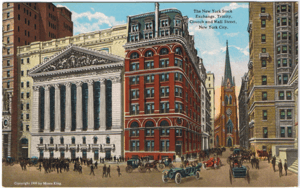
In the years after the NYSE Building's completion, the exchange encountered difficulties. Following the Panic of 1907 in which the NYSE dropped by almost fifty percent from a peak the previous year, two government investigations in 1909 and 1912 led to the passage of the Federal Reserve Act of 1913. Furthermore, the onset of World War I in Europe in 1914 led many investors to liquidate their securities for gold. As a result, the NYSE trading floor was fully closed for four months in 1914, the first time such a prolonged closure had occurred. The trading of war stocks led to an increase in business at the New York Curb Exchange outside the NYSE Building and, by 1916, the NYSE was contemplating allowing the Curb to move inside. This plan failed and the Curb built its own structure at 86 Trinity Place, several blocks to the west, in 1921. In addition, the Wall Street bombing occurred outside the building on September 16, 1920, killing thirty-eight people and injuring hundreds more.
In its first two decades, and especially following the end of World War I, the NYSE grew significantly. The rebuilt 18 Broad Street quarters quickly became insufficient for the exchange's needs. In December 1918, the NYSE bought the Mortimer Building northeast of its existing structure, giving the exchange an additional 3,220 square feet (299 m2). The annex would give the building a full frontage on Wall Street, whereas previously 18 Broad Street only ran along Wall Street for 15 feet (4.6 m). The Mortimer Building's demolition commenced in mid-1919. The NYSE also leased the Wilks Building northwest of its existing structure in January 1920; the lot was assessed at $1.9 million. Demolition of the Wilks Building commenced in June 1920.
Trowbridge and Livingston were given the commission to design an annex on the Mortimer and Wilks sites. Marc Eidlitz and Son was given the construction contract for the construction of the annex. Plans for an annex at 11 Wall Street, reaching twenty-two stories above a basement, were finalized in February 1920. The first eight stories and the basement were to be taken by the NYSE, including several stories for an expanded trading floor known as the "Garage". The upper stories would be leased to office tenants. By August 1922, the annex was nearly complete, and several firms had already signed leases for about 60 percent of the available office space. The annex's trading floor opened during the last week of December 2022.
1920s to 1960s
The office annex was not sufficient to accommodate the long-term growth of the NYSE. In mid-1926, the NYSE leased three floors at the neighboring Commercial Cable Building on 20 Broad Street. The ground floor would be connected to that of 18 Broad Street, while the first and second floors of that building were to be combined into a single bond trading room with a high ceiling. These stories were internally connected to 18 Broad Street, although they remained separate buildings. In 1928, the NYSE bought not only the Commercial Cable Building but also the Blair Building on the same block, giving the NYSE a leasehold or ownership over all the property on the city block.
The NYSE's growth stopped suddenly with the Wall Street Crash of 1929, when share prices on the exchange collapsed, in what was cited as one cause of the Great Depression. During the Depression, the NYSE trading floor was closed for over a week in March 1933, after president Franklin D. Roosevelt signed the Emergency Banking Act. The marble sculptures of the pediment on Broad Street, which had deteriorated over the years, were replaced in 1936. The new figures were made of metal, though this fact was kept secret for eighteen years. At the end of the Great Depression, the NYSE started to grow again. During World War II, women were allowed on the building's trading floor for the first time in the NYSE's history.
By 1954, the NYSE was planning to replace the Commercial Cable and Blair Buildings with a 27-story skyscraper at 20 Broad Street, designed by Kahn & Jacobs. Part of the skyscraper was to be used for auxiliary facilities for the NYSE, and the exchange formally held an option to expand its trading floor to 20 Broad Street if the need arose. That structure was completed in 1957 and sold to the New York Life Insurance Company two years later. The NYSE initially used the second through fourth floors at 20 Broad Street, corresponding to the first through third floors of its main building, as exhibition space.
By the early 1960s, the NYSE needed to expand its operations again and was considering moving out of its main building entirely. The building had housed some securities firms that were also members of the exchange, but the NYSE now needed the space for itself, and the last firm moved out during late 1961. At that time, the NYSE's leadership hoped to acquire land in Lower Manhattan and construct a new building within five years. The exchange selected a site in Battery Park City in 1965, but dropped plans for the site the next year. The NYSE's governors voted in 1967 to expand the trading floor into 20 Broad Street. The expansion, nicknamed the "Blue Room", opened in July 1969. It provided 8,000 square feet (740 m2) of additional space to the 23,000-square-foot (2,100 m2) trading floor, which could accommodate almost two hundred more clerks. In addition, some of the computer facilities were moved to Paramus, New Jersey, between 1967 and 1969.
1970s to present
The NYSE was looking in the long term to build a new headquarters along the East River, at the eastern end of Wall Street. These plans were postponed indefinitely in 1970 due to the recession of 1969–1970. The NYSE was looking to expand its trading floor again and, in 1985, announced an $11 million extension of the Blue Room at 20 Broad Street, which would add 7,000 square feet (650 m2) to the trading floor. This expansion was completed by 1988. The original bell in the main trading floor was replaced in the late 1980s.
The NYSE, American Stock Exchange, and J.P. Morgan & Co. considered a plan to create a financial "supercenter" immediately east of the NYSE Building, across Broad Street, in 1992. In addition, the NYSE resumed its search for alternate sites for its headquarters in the mid-1990s. The sites being considered included Bowling Green at the southern end of Manhattan, as well as the East River site at the end of Wall Street. Another site under consideration was the Broad Exchange Building immediately to the southeast. City authorities offered substantial tax incentives to try to keep the NYSE in the Financial District, which in turn raised the cost of the new building. As an interim solution, in 1998, the NYSE looked into opening a trading floor at 30 Broad Street less than a block to the south. The expansion opened in late 2000.
The September 11 attacks in 2001, which resulted in the collapse of the World Trade Center nearby, resulted in a multi-day closure of the NYSE's trading floor, only the third time this had occurred in the building's history. The Lower Manhattan expansion to the NYSE was ultimately canceled in 2002; the NYSE sought to open its additional trading floor elsewhere to ensure it could keep operating if its main building was targeted by terrorists. Over the following years, the increase in electronic trading made physical trading space redundant; the floor accounted for less than half of trades in 2007, down from 80 percent in 2004. As a result, the 30 Broad Street trading floor closed in February 2007. The Blue Room and Extended Blue Room were announced for closure later that year, leaving only the main floor and the Garage. The NYSE Building's trading floor was closed for two months in 2020 during the COVID-19 pandemic in New York City, but electronic trading continued throughout.
Impact
Cultural impact
The NYSE's logo, on which the NYSE holds a trademark, depicts the columns on the 18 Broad Street building. This has led to disputes when coupled with the building's status as an icon of the NYSE. For instance, in 1999, the NYSE unsuccessfully sued the New York-New York Hotel and Casino for trademark infringement after the casino built the "New York-New York $lot Exchange", loosely based on 18 Broad Street.
The NYSE Building's prominence has also made it the location of artwork. In 1989, artist Arturo Di Modica installed his sculpture Charging Bull in front of the building, in an act of guerrilla art. The sculpture was removed within a day and ultimately reinstalled at Bowling Green, two blocks south. Subsequently, in 2018, Kristen Visbal's bronze sculpture Fearless Girl was installed outside the NYSE Building on Broad Street. The Fearless Girl sculpture had faced Charging Bull when it was installed at Bowling Green in 2017, but it was moved to the NYSE due to complaints from Di Modica.
Landmark designations
As early as 1965, the New York City Landmarks Preservation Commission (LPC) had considered designating the 18 Broad Street building, but not the 11 Wall Street annex, as a landmark. It was one of the first buildings to be proposed for landmark status by the LPC, which that year had gained the authority to designate the city's structures as landmarks. However, the NYSE was opposed to landmark status at the time. A second landmark hearing was held in 1980, but this again was successful. The New York Times, in 1983, cited the NYSE Building as one of several prominent structures that had not been designated by the LPC in the agency's first eighteen years, alongside Rockefeller Center and the Woolworth Building. The LPC reconsidered designation for 18 Broad Street in 1985. After numerous public hearings, the LPC finally granted landmark status to 18 Broad Street on July 9, 1985.
Both 18 Broad Street and 11 Wall Street were added to the National Register of Historic Places (NRHP) as a National Historic Landmark in 1978. The building was designated as a contributing property to the Wall Street Historic District, a National Register of Historic Places district, in 2007.
Images for kids
See also
 In Spanish: New York Stock Exchange Building para niños
In Spanish: New York Stock Exchange Building para niños




